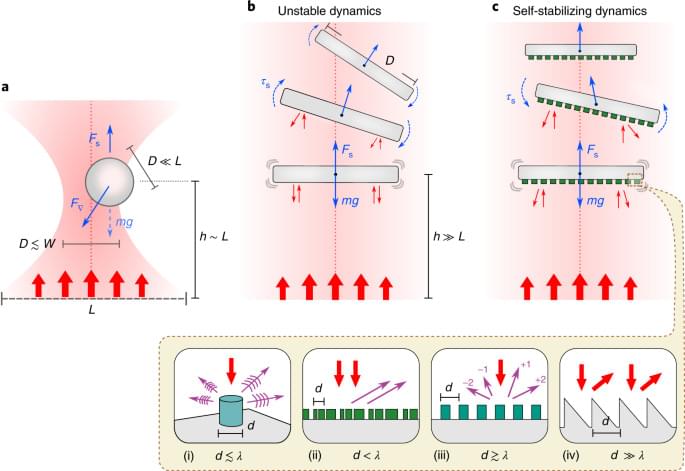Circa 2009 o.o!!
The feat, done with magnetic fields, could lead to better understanding of zero-g bone loss.


Circa 2019
Mechanical stability of macroscopic structures on the millimetre-, centimetre-and even metre-scale could be realized by tailoring the anisotropy of light scattering along the object’s surface, without needing to focus incident light or excessively constrain the shape, size or material composition of the object.

According to a research paper published in Nature, astronomers detected a “really weird” object 4,000 lightyears distant from Earth. Every other minute, the object vanishes from view and produces a massive burst of radio waves three times an hour. Tyrone O’Doherty, a Curtin University student, first noticed the enigmatic object while scanning the sky in […].

The frightening future implications of new report from researchers at the Weizmann Institute of Science in Israel caused a stir among observers of the international science community.
Using neither sperm nor egg, researchers created the world’s first synthetic mouse embryo and watched it grow for over eight days inside of a specially designed bioreactor that served as a womb, according to Live Science Magazine.
The article describes what occurs inside the artificial womb. “Within the device, embryos float in small beakers of nutrient-filled solution, and the beakers are all locked into a spinning cylinder that keeps them in constant motion. This movement simulates how blood and nutrients flow to the placenta. The device also replicates the atmospheric pressure of a mouse uterus.”


For one month Rob Greenfield lived just like the average person and WORE every single piece of trash he created. Why? To create a visual of how much trash just one of us creates and serve as a mirror to society to self-reflect, question habits and explore alternatives to live in balance with Earth.
Rob Greenfield is an activist and humanitarian dedicated to leading the way to a more sustainable and just world. He embarks on extreme projects to bring attention to important global issues and inspire positive change. His work has been covered by media worldwide including National Geographic and he’s been named “The Robin Hood of modern times” by France 2 TV. This talk was given at a TEDx event using the TED conference format but independently organized by a local community.
Nicely done Tim!
https://www.timventura.com — Dr. Natasha Vita-More discusses transhumanism, human augmentation, life extension, and cryopreservation, and provides valuable insights into the latest medical advances empowering body augmentation & super-longevity in humans.
Our interview begins with a philosophical discussion of transhumanism, including what it is and why this emerging community is growing so rapidly — as it is driven forward by rapid advances in medical technology and an aging boomer population.
We also discuss the work of Dr. David Sinclair, Liz Parrish and Bioviva Sciences, Alcor, and a collection of notable authors, thinkers, and scientists pushing the boundaries of what it means to be human in the 21st century.
Dr. Natasha Vita-More is a pioneering leader and community organizer in transhumanism, and a proponent of human rights, morphological freedom, and ethical means for human enhancement.
Great talk on BMIs, the future of life and intelligence:
Lex Fridman Podcast full episode: https://www.youtube.com/watch?v=1YbcB6b4A2U
Please support this podcast by checking out our sponsors:
- Four Sigmatic: https://foursigmatic.com/lex and use code LexPod to get up to 60% off.
- NetSuite: http://netsuite.com/lex to get free product tour.
- Grammarly: https://grammarly.com/lex to get 20% off premium.
- ExpressVPN: https://expressvpn.com/lexpod and use code LexPod to get 3 months free.
GUEST BIO:
Bryan Johnson is the founder and CEO of Kernel, OS Fund, and previously Braintree.
PODCAST INFO:
Podcast website: https://lexfridman.com/podcast.
Apple Podcasts: https://apple.co/2lwqZIr.
Spotify: https://spoti.fi/2nEwCF8
RSS: https://lexfridman.com/feed/podcast/
Full episodes playlist: https://www.youtube.com/playlist?list=PLrAXtmErZgOdP_8GztsuKi9nrraNbKKp4
Clips playlist: https://www.youtube.com/playlist?list=PLrAXtmErZgOeciFP3CBCIEElOJeitOr41
SOCIAL:

The Neuro-Network.
𝐒𝐭𝐚𝐧𝐟𝐨𝐫𝐝 𝐍𝐞𝐮𝐫𝐨𝐬𝐜𝐢𝐞𝐧𝐭𝐢𝐬𝐭: 𝐑𝐞𝐣𝐮𝐯𝐞𝐧𝐚𝐭𝐢𝐧𝐠 𝐀𝐠𝐢𝐧𝐠 𝐁𝐫𝐚𝐢𝐧𝐬
𝙎𝙩𝙖𝙣𝙛𝙤𝙧𝙙 𝙣𝙚𝙪𝙧𝙤𝙨𝙘𝙞𝙚𝙣𝙩𝙞𝙨𝙩 𝙏𝙤𝙣𝙮 𝙒𝙮𝙨𝙨-𝘾𝙤𝙧𝙖𝙮, 𝙋𝙝𝘿, 𝙝𝙖𝙨 𝙨𝙥𝙚𝙣𝙩 20 𝙮𝙚𝙖𝙧𝙨 𝙙𝙞𝙨𝙘𝙤𝙫𝙚𝙧𝙞𝙣𝙜 𝙖𝙣𝙙 𝙞𝙣𝙫𝙚𝙨𝙩𝙞𝙜𝙖𝙩𝙞𝙣𝙜 𝙫𝙖𝙧𝙞𝙤𝙪𝙨 𝙢𝙤𝙡𝙚𝙘𝙪… See more.
Stanford neuroscientist Tony Wyss-Coray has spent 20 years unearthing and examining various molecules with neuroprotective and neurodegenerative properties.
Stanford neuroscientist Tony Wyss-Coray, PhD, has spent 20 years discovering and investigating various molecules with neuroprotective and neurodegenerative properties. These molecules are found in or on different cell types in the brain and on the blood vessels abutting it or floating in the blood and the cerebrospinal fluid that bathes it. As we age they become increasingly important.
Wyss-Coray and his colleagues have discovered substances in blood that can accelerate or slow down the brain-aging clock. They’ve identified proteins on blood-vessel surfaces through which some of these molecules can act on the brain, despite the existence of the blood-brain barrier. He’s even shown that older mice look and act younger after receiving young mouse cerebrospinal fluid.